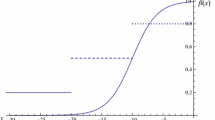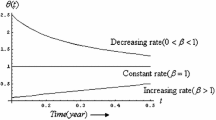Abstract
We study an inventory system where demand on the stockout period is partially backlogged. The backlogged demand ratio is a mixture of two exponential functions. The shortage cost has two significant costs: the unit backorder cost (which includes a fixed cost and a cost proportional to the length of time for which the backorder exists) and the cost of lost sales. A general procedure to determine the optimal policy and the minimum inventory cost for all the parameter values is developed. This model generalizes several inventory systems analyzed by different authors. Numerical examples are used to illustrate the theoretical results.
Similar content being viewed by others
References
Abad, P. L. (1996). Optimal pricing and lot-sizing under conditions of perishability and partial backordering. Management Science, 42, 1093–1104.
Abad, P. L. (2003). Optimal pricing and lot-sizing under conditions of perishability,finite production and partial backordering and lost sale. European Journal of Operational Research, 144, 677–685. doi:10.1016/S0377-2217(02)00159-5.
Chu, P. L., Yang, K. L., Liang, S. K., & Niu, T. (2004). Note on inventory model with a mixture of back orders and lost sales. European Journal of Operational Research, 159, 470–475. doi:10.1016/S0377-2217(03)00416-8.
Chung, K. J., Goyal, S. K., & Huang, Y. F. (2005). The optimal inventory policies under permissible delay in payments depending on the ordering quantity. International Journal of Production Economics, 95, 203–213. doi:10.1016/j.ijpe.2003.12.006.
Dye, C. Y., Chang, H. J., & Teng, J. T. (2006). A deteriorating inventory model with time-varying demand and shortege-dependent partial backlogging. European Journal of Operational Research, 172, 417–429. doi:10.1016/j.ejor.2004.10.025.
Hadley, G., & Whitin, T. M. (1963). Analysis of inventory systems. Englewood Cliffs: Prentice-Hall
Hanssmann, F. (1962). Operations research in production and inventory control. New York: Wiley.
Naddor, E. (1966). Inventory systems. New York: Wiley
Ouyang, L. Y., Hsieh, T. P., Dye, C. Y., & Chang, H. C. (2003). An inventory model for deteriorating items with stock-dependent demand under the condictions of inflation and time-value of money. The Engineering Economist, 48, 52–68. doi:10.1080/00137910308965051.
Padmanabhan, G., & Vrat, P. (1990). Inventory model with a mixture of back orders and lost sales. International Journal of Systems Sciences, 21, 1721–1726. doi:10.1080/00207729008910488.
Padmanabhan, G., & Vrat, P. (1995). EOQ models for perishable items under stock dependent selling rate. European Journal of Operational Research, 86, 281–292. doi:10.1016/0377-2217(94)00103-J.
Papachristos, S., & Skouri, K. (2000). An optimal replenishment policy for deteriorating items with time-varying demand and partial – exponential type – backlogging. Operations Research Letters, 27, 175–184. doi:10.1016/S0167-6377(00)00044-4.
Posner, M. J., & Yansouni, B. (1972). A class of inventory models with customer impatience. Naval Research Logistics Quarterly, 19, 483–493. doi:10.1002/nav.3800190308.
San José, L. A., Sicilia, J., & Garcia-Laguna, J. (2006). Analysis of an inventory system with exponential partial backordering. International Journal of Production Economics, 100, 76–86. doi:10.1016/j.ijpe.2004.10.012.
Skouri, K., & Papachristos, S. (2002). A continuous review inventory model, with deteriorating items, time-varying demand, linear replenishment cost, partially time-varying backlogging. Applied Mathematical Modelling, 26, 603–617. doi:10.1016/S0307-904X(01)00071-3.
Zhou, Y. W., Lau, H. S., & Yang, S. L. (2003). A new variable production scheduling strategy for deteriorating items with time-varying demand and partial lost sale. Computers and Operations Research, 30, 1753–1776. doi:10.1016/S0305-0548(02)00104-1.
Zhou, Y. W. (2003). A multi-warehouse inventory model for items with time-varying demand and shortages. Computers and Operations Research, 30, 2115–2134. doi:10.1016/S0305-0548(02)00126-0.
Zipkin, P. H. (2000). Foundations of inventory management. Singapore: McGraw-Hill.
Author information
Authors and Affiliations
Corresponding author
Rights and permissions
About this article
Cite this article
Sicilia, J., San-José, L.A. & García-Laguna, J. An optimal replenishment policy for an EOQ model with partial backlogging. Ann Oper Res 169, 93–115 (2009). https://doi.org/10.1007/s10479-008-0393-3
Published:
Issue Date:
DOI: https://doi.org/10.1007/s10479-008-0393-3




